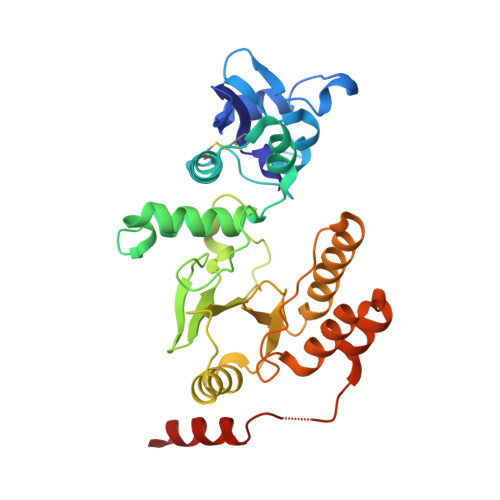Phosphorylation cascade regulates the formation and maturation of rotaviral replication factories.
Criglar, J.M., Anish, R., Hu, L., Crawford, S.E., Sankaran, B., Prasad, B.V.V., Estes, M.K.(2018) Proc Natl Acad Sci U S A 115: E12015-E12023
- PubMed: 30509975
- DOI: https://doi.org/10.1073/pnas.1717944115
- Primary Citation of Related Structures:
6AUK, 6CY9, 6CYA - PubMed Abstract:
The rotavirus (RV) genome is replicated and packaged into virus progeny in cytoplasmic inclusions called viroplasms, which require interactions between RV nonstructural proteins NSP2 and NSP5. How viroplasms form remains unknown. We previously found two forms of NSP2 in RV-infected cells: a cytoplasmically dispersed dNSP2, which interacts with hypophosphorylated NSP5; and a viroplasm-specific vNSP2, which interacts with hyperphosphorylated NSP5. Other studies report that CK1α, a ubiquitous cellular kinase, hyperphosphorylates NSP5, but requires NSP2 for reasons that are unclear. Here we show that silencing CK1α in cells before RV infection resulted in ( i ) >90% decrease in RV replication, ( ii ) disrupted vNSP2 and NSP5 interaction, ( iii ) dispersion of vNSP2 throughout the cytoplasm, and ( iv ) reduced vNSP2 protein levels. Together, these data indicate that CK1α directly affects NSP2. Accordingly, an in vitro kinase assay showed that CK1α phosphorylates serine 313 of NSP2 and triggers NSP2 octamers to form a lattice structure as demonstrated by crystallographic analysis. Additionally, a dual-specificity autokinase activity for NSP2 was identified and confirmed by mass spectrometry. Together, our studies show that phosphorylation of NSP2 involving CK1α controls viroplasm assembly. Considering that CK1α plays a role in the replication of other RNA viruses, similar phosphorylation-dependent mechanisms may exist for other virus pathogens that require cytoplasmic virus factories for replication.
Organizational Affiliation:
Department of Molecular Virology and Microbiology, Baylor College of Medicine, Houston, TX 77030.















